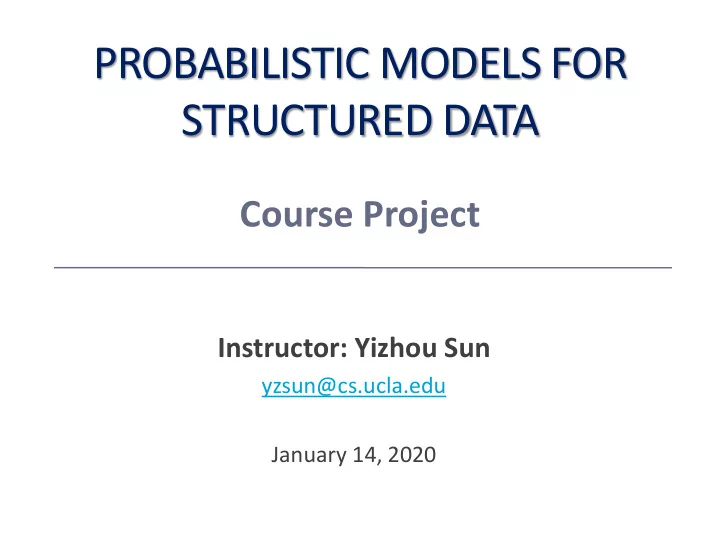

PROBABILISTIC MODELS FOR STRUCTURED DATA Course Project Instructor: Yizhou Sun yzsun@cs.ucla.edu January 14, 2020
Overview • Goal: design a probabilistic graphical model to solve real-world problems, and write a report that is potentially submitted to some venue for publication • Teamwork • 3-4 people per group • Milestones • Team formation due date: Week 2 (1pt as participation) • Proposal due date: Week 5 (5pt) • Presentation due date: 3/12/2020 in class (20pt) • Final report due date: 3/13/2020 (15pt) • What to submit: project report and code 2
Report Guideline • Format: no more than 8-page, ACM SIG template: https://www.acm.org/publications/proceedings- template-16dec2016: • 1. Title with group information (group # and name, group member names) 2. Abstract 3. Introduction of the overall goal and background 4. Problem definition and formalization 5. Methods description (detailed steps) 6. Experiments design and Evaluation • 7. Related work 8. Conclusion • 9. References 3
Breakdown Points 4. Report writing 1. Is the problem 2. Is the solution solid 3. Is there comparison formalization and reasonable? with alternative Quality reasonable? approaches with reasonable evaluation? 4
Problem 1: Paper Classification in Directed Citation Network • Cora Dataset: • http://www.cs.umass.edu/ ∼ mccallum/code- data.html • Cora.zip • Label: Each paper is associated with a research topic • There is a hierarchy structure in the dataset, please use the top hierarchy as labels • Feature: Each paper has words extracted from title 5
• Task: • Design a probabilistic graphical model to leverage the citation links to classify papers into research topics • Questions to address: • How to take the asymmetry in citation relation into the potential function design? • Design asymmetry potential function and implement it correctly • Will the consideration of asymmetry improve the classification accuracy? • Compare with the solution that simply ignores the asymmetry 6
• Evaluation: • Hide p% labels as test, use the remaining as training • Vary p to see its impact to the classification accuracy • Evaluation metric for multi-label classification 7
Problem 2: Node Classification in Heterogeneous Bibliographic Network • Dataset • four_area.zip • Label: authors and venues are associated with one of the four research areas, i.e., DB, DM, ML, IR • Label information can be found on DBLP_four_area.zip • Feature: Only Papers are associated with text information 8
• Task: • Design a probabilistic graphical model to classify all the objects into four category in the network • Questions to address: • How to leverage different types of links in the network? • Design different types of potential functions for different types of links by assuming different parameters • Will the consideration of type information for links improve the performance? • Compare the solution that treats all the links equally 9
• Evaluation: • Hide p% labels as test, use the remaining as training • Vary p to see its impact to the classification accuracy • Evaluation metric for multi-label classification • Evaluation when multiple types of nodes exist 10
Project 3: Polarity Detection for Twitter Users • Dataset: Crawl Twitter Users following Political figures, their following, retweet, and reply behaviors, as well as their tweets • Task: Design a probabilistic graphical model to classify all the users into two polarities 11
Project 4: Knowledge Completion for Knowledge Graphs via Higher-Order Dependency Modeling • Datasets: Knowledge Graphs, such as YAGO, FreeBase, and NELL • Task: Design a probabilistic graphical model to that can leverage higher-order dependency to solve knowledge graph completion tasks • i.e., < h,r,?> 12
Project 5: Construct CS Taxonomy from Wiki • Dataset: Wikipedia • Task: construct taxonomy for terms related to computer science • E.g., root node: “computer science” https://www.researchgate.net/figure/Computer-Science-Taxonomy_fig1_260318181 13
Project 6: NER for Wiki Pages in CS • Dataset: Wikipedia • Task: Conduct NER task for text of wiki pages • Categories: concept (e.g., machine learning, deep learning); algorithm (e.g., CNN); application (e.g., self driving car); dataset (e.g., ImageNet), etc. 14
Recommend
More recommend